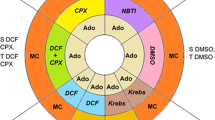Summary
5′-Nucleotidase and purine nucleoside phosphorylase, two key enzymes in nucleoside metabolism, have been localized electronmicroscopically in left ventricular myocardium of the human, dog, pig, rabbit, guinea pig and rat. Ectonucleotidase activity was present in all species at the plasma membrane of pericytes. Reactive endothelial cells in the microcirculatory bed were restricted to those covering resistance arterioles. Cardiomyocytes were reactive only in the rat. Purine nucleoside phosphorylase was localized uniformly in the vascular endothelium of all species. The strongest activity was seen in the pericytes of guinea pig, rat and dog. Pericytes of rabbit and pig were virtually unreactive, whereas a minority of cells in human samples were positive. Cardiomyocytes were unreactive in all species. These variations in the distribution pattern of adenosine metabolic sites may have definite consequences for disposal and recovery of adenylates and their breakdown products in ischaemia and for the effects to be expected from interference with nucleoside transport inhibition.
Similar content being viewed by others
References
BECKER, B., REINHOLZ, N., OZCELIK, T., LEIPERT, B. & GERLACH, E. (1989) Uric acid as radical scavenger and antioxidant in the heart.Eur. J. Physiol. 415, 127–35.
BERNE, R. M. (1980) The role of adenosine in the regulation of coronary blood flow.Circ. Res. 47, 807–13.
BERNE, R., RUBIO, R., DOBSON, J. & CURNISH, R. (1971) Adenosine and adenine nucleotides as possible mediators of cardiac and skeletal muscle blood flow regulation.Cir. Res. 28 (suppl. I) 115–9.
BORGERS, M. & THONÉ, F. (1975) The inhibition of alkaline phosphatase by 1-p-bromotetramisole.Histochem. 44, 277–80.
BORGERS, M. & VERHEYEN, A. (1985) Enzyme cytochemistry. InInternational Review of Cytology (edited byBourne, G. H. & Danielli, J. F.), Vol. 95, pp. 163–227. Orlando, FL: Academic Press.
BORGERS, M., SCHAPER, J. & SCHAPER, W. (1971) Adenosine-producing sites in the mammalian heart: a cytochemical study.J. Mol. Cell. Cardiol. 3, 287–96.
BORGERS, M., SCHAPER, J. & SCHAPER, W. (1972) Nucleoside phosphorylase activity in blood vessels and formed elements of the blood of the dog.J. Histochem. Cytochem. 20, 1041–8.
CHECHIK, B. E., BAUMAL, R. & Sengupta, S. (1983) Localization and identity of adenosine deaminase-positive cells in tissues of the young rat and calf.Histochem. J. 15, 373–87.
FLAMENG, W., WOUTERS, L., SERGEANT, P., LEWI, P., BORGERS, M., Thoné, F. & Suy, R. (1984) Multivariate analysis of angiographic, histologic, and electrocardiographic data in patients with coronary heart disease.Circulation 70, 7–17.
GERLACH, E. & DEUTICKE, B. (1966) Vergleichende Untersuchungen über die Bildung von Adenosin in Myokard verschiedener Tierspecies bei Sauerstoffmangel.Klin. Wschr. 22, 1307–10.
NEES, S. (1989) Coronary flow increases induced by adenosine and adenine nucleotides are mediated by the coronary endothelium: a new principle of the regulation of coronary flow.Eur. Heart J. 10, (suppl. F.) 28–35.
NEES, S. & DENDORFER, A. (1990) Einfluß des koronaren Mikrogefäßsystems auf den Adeninnukleotidstoffwechsel und daraus abgeleitete Funktionen des Herzens.Internist 31, 617–24.
NEES, S., HERZOG, V., BECKER, B. F., BÖCK, M., DES ROSIERS, Ch. & GERLACH, E. (1985) The coronary endothelium: a highly active metabolic barrier for adenosine.Basic Res. Cardiol. 80, 515–29.
RUBIO, R. & BERNE, R. (1970) Sites of nucleoside in myocardial cells.Circulation 41–42 (suppl. III) 62.
RUBIO, R., WIEDMEIER, T. & BERNE, R. (1972) Nucleoside phosphorylase: localization and role in the myocardial distribution of purines.Am. J. Physiol. 222, 550–5.
SCHRADER, W. & WEST, C. (1990) Localization of adenosine deaminase and adenosine deaminase complexing protein in rabbit heart.Circ. Res. 66, 754–62.
SPARKS, H. & BARDENHEUER, H. (1986) Regulation of adenosine formation by the heart.Circ. Res. 58, 193–201.
VAN BELLE, H., WYNANTS, J. & GOOSSENS, F. (1985) Formation and release of nucleosides in the ischemic myocardium. Is the guinea-pig the exception?Basic Res. Cardiol. 80, 653–60.
Van Belle, H., Goossens, F. & Wynants, J. (1987) Formation and release of purine catabolites during hypoperfusion, anoxia, and ischemia.Am. J. Physiol. H886-93.
Author information
Authors and Affiliations
Rights and permissions
About this article
Cite this article
Borgers, M., Thoné, F. Species differences in adenosine metabolic sites in the heart. Histochem J 24, 445–452 (1992). https://doi.org/10.1007/BF01089106
Received:
Revised:
Issue Date:
DOI: https://doi.org/10.1007/BF01089106




